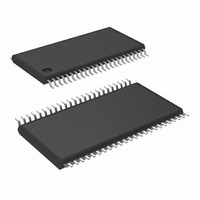COP8CCE9IMT7/NOPB National Semiconductor, COP8CCE9IMT7/NOPB Datasheet - Page 57

COP8CCE9IMT7/NOPB
Manufacturer Part Number
COP8CCE9IMT7/NOPB
Description
MCU 8BIT FLASH 8K MEM 48-TSSOP
Manufacturer
National Semiconductor
Series
COP8™ 8Cr
Datasheet
1.I2C-CPEV.pdf
(80 pages)
Specifications of COP8CCE9IMT7/NOPB
Core Processor
COP8
Core Size
8-Bit
Speed
10MHz
Connectivity
Microwire/Plus (SPI), UART/USART
Peripherals
Brown-out Detect/Reset, POR, PWM, WDT
Number Of I /o
39
Program Memory Size
8KB (8K x 8)
Program Memory Type
FLASH
Ram Size
256 x 8
Voltage - Supply (vcc/vdd)
2.7 V ~ 5.5 V
Data Converters
A/D 16x10b
Oscillator Type
Internal
Operating Temperature
-40°C ~ 125°C
Package / Case
48-TSSOP
Data Bus Width
8 bit
Maximum Clock Frequency
10 MHz
Data Ram Size
256 B
On-chip Adc
10 bit, 16 channel
Number Of Programmable I/os
37
Number Of Timers
2
Height
0.9 mm
Interface Type
SPI, USART
Length
12.5 mm
Maximum Operating Temperature
+ 125 C
Minimum Operating Temperature
- 40 C
Supply Voltage (max)
5.5 V
Supply Voltage (min)
2.7 V
Width
6.1 mm
Lead Free Status / RoHS Status
Lead free / RoHS Compliant
Eeprom Size
-
Lead Free Status / Rohs Status
Details
Other names
COP8CCE9IMT7
16.0 Interrupts
The default VIS interrupt vector can be useful for applica-
tions in which time critical interrupts can occur during the
servicing of another interrupt. Rather than restoring the pro-
gram context (A, B, X, etc.) and executing the RETI instruc-
tion, an interrupt service routine can be terminated by return-
ing to the VIS instruction. In this case, interrupts will be
serviced in turn until no further interrupts are pending and
the default VIS routine is started. After testing the GIE bit to
ensure that execution is not erroneous, the routine should
restore the program context and execute the RETI to return
to the interrupted program.
This technique can save up to fifty instruction cycles (t
more, (50 µs at 10 MHz oscillator) of latency for pending
interrupts with a penalty of fewer than ten instruction cycles
if no further interrupts are pending.
Note 22: y is a variable which represents the VIS block. VIS and the vector table must be located in the same 256-byte block except if VIS is located at the last
address of a block. In this case, the table must be in the next block.
16.3.1 VIS Execution
When the VIS instruction is executed it activates the arbitra-
tion logic. The arbitration logic generates an even number
between E0 and FE (E0, E2, E4, E6 etc....) depending on
which active interrupt has the highest arbitration ranking at
the time of the 1st cycle of VIS is executed. For example, if
the software trap interrupt is active, FE is generated. If the
external interrupt is active and the software trap interrupt is
not, then FA is generated and so forth. If no active interrupt
is pending, than E0 is generated. This number replaces the
lower byte of the PC. The upper byte of the PC remains
unchanged. The new PC is therefore pointing to the vector of
(1) Highest
(2)
(3)
(4)
(5)
(6)
(7)
(8)
(9)
(10)
(11)
(12)
(13)
(14)
(15)
(16) Lowest
Arbitration Ranking
(Continued)
Software
Reserved for NMI
External
Timer T0
Timer T1
Timer T1
MICROWIRE/PLUS
Reserved
USART
USART
Timer T2
Timer T2
Reserved
Reserved
Port L/Wake-up
Default VIS
Source Description
TABLE 26. Interrupt Vector Table
C
), or
INTR Instruction
G0
Underflow
T1A/Underflow
T1B
BUSY Low
Receive
Transmit
T2A/Underflow
T2B
Port L Edge
Reserved
57
To ensure reliable operation, the user should always use the
VIS instruction to determine the source of an interrupt. Al-
though it is possible to poll the pending bits to detect the
source of an interrupt, this practice is not recommended. The
use of polling allows the standard arbitration ranking to be
altered, but the reliability of the interrupt system is compro-
mised. The polling routine must individually test the enable
and pending bits of each maskable interrupt. If a Software
Trap interrupt should occur, it will be serviced last, even
though it should have the highest priority. Under certain
conditions, a Software Trap could be triggered but not ser-
viced, resulting in an inadvertent “locking out” of all
maskable interrupts by the Software Trap pending flag.
Problems such as this can be avoided by using VIS
instruction.
the active interrupt with the highest arbitration ranking. This
vector is read from program memory and placed into the PC
which is now pointed to the 1st instruction of the service
routine of the active interrupt with the highest arbitration
ranking.
Figure 30 illustrates the different steps performed by the VIS
instruction. Figure 31 shows a flowchart for the VIS instruc-
tion.
The non-maskable interrupt pending flag is cleared by the
RPND (Reset Non-Maskable Pending Bit) instruction (under
certain conditions) and upon RESET.
0yFE–0yFF
0yFC–0yFD
0yFA–0yFB
0yF8–0yF9
0yF6–0yF7
0yF4–0yF5
0yF2–0yF3
0yF0–0yF1
0yEE–0yEF
0yEC–0yED
0yEA–0yEB
0yE8–0yE9
0yE6–0yE7
0yE4–0yE5
0yE2–0yE3
0yE0–0yE1
Vector Address (Note 22)
(Hi-Low Byte)
www.national.com










